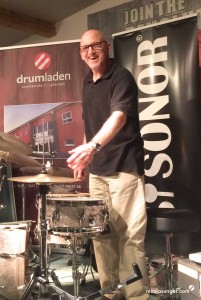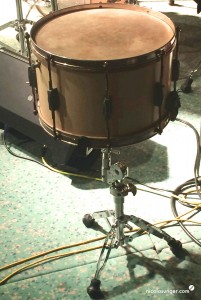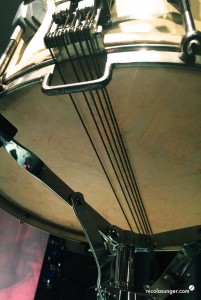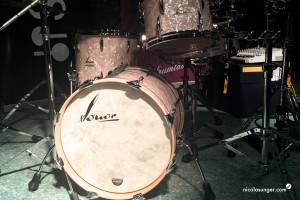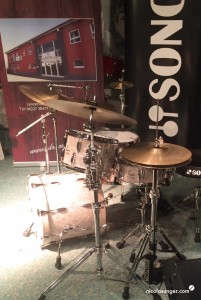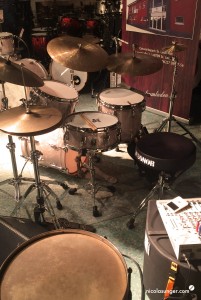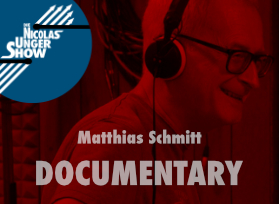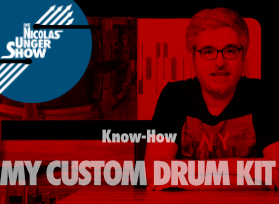Drum Clinic with Adam Nussbaum
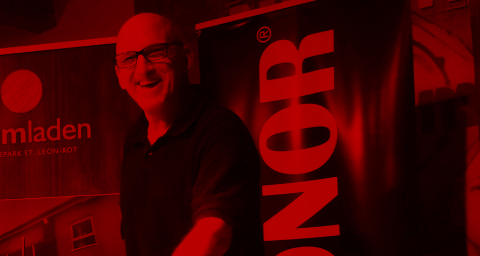
As the workshop begins, a good-humored Adam Nussbaum enters the stage at german drum shop drumladen. He is an affable guy and stands for jazz and fusion drumming on the highest musical level. And he also challenges his audience. As it can not fully fulfill his requirements, his otherwise good mood darkens in the meantime. More on that later.
Now on the subjects, as Adam Nussbaum addressed them:
LISTENING
Adam Nussbaum briefly confused the audience after his introductory solo with the question “What did you hear at first – even before I played” So what did we hear – even before he started to play? Adam: „Sound! You hear it all the time, even before someone starts playing music“. Only after that you are paying attention to other things: Do I like the musicians feel, his Groove etc.
If you do not like what you hear: Hear nevertheless accurately! You will learn, one way or the other, Nussbaum says.
The most interesting question that you should ask yourself when listening to a drummer is: Why does he/she playing this? You get the answer by listening to the whole music and not just to the drummer. The answer lies in the music.
Do not play with earplugs in your ears! If it’s too loud for you – learn to play more quietly! (That´s Nussbaum’s opinion and – in my view – it´s open for discussion.). At the same time you shall nevertheless be able to play intense. That is the most difficult part: to play quietly AND intensely.
If you play with a singer, go out of the way! Don´t ruin it. When the singer breathes you can play a “mini thing” in the right place.
Learn to understand how your playing sounds in the audience!
IMAGINATION
He tells the story of Louis Armstrong, playing with a mediocre band and still sounding fantastic. When asked why he sounded so good, he answered that he had played with his own band in his head.
SOLOING
1% of the time you play solo, 99% of the time is playing and listening.
When playing solo, do not play anything complicated. Think of a tune and go from there. A solo from Adam as an example.
TIMING
He does not play to the click. He is booked for HIS time!
Play your time! It is not your job as to make a sloppy bass player sound good. That’s his problem.
He had to acquire precision over time.
PHRASING
Adam Nussbaum tells the story of Little Richard who did not want to hear the shuffle from his drummers. They should accompany his left hand (at the piano) with straight eighth notes on the hi-hat. But his blues and shuffle drummers did not play like that. They played the eith notes between the binary and ternary feel. He calls it the “Grey Space” and adds: “That’s where it gets interesting“.
About the playing on the ride cymbal in jazz, he says: The quarter notes may be plaed at the same place by different drummers, but the “tu” can be placed very differently.
LERNING
How humans learn: We learn to walk not by reading a book. We see someone else walking. Then we want to do it as well. We try and fall down hundreds of times. But we go on (= endurance) and at the end we can walk.
His tip for music: Imitate what you hear. Attempt to sound like that and then do your own thing.
„See the old ones first.“
FEEL
The music has many aspects such as the brain, fingers, reading, coordination, etc., but the most important are „Spirit, Feel and Soul – whatever you might call it“.
RECORDING
Currently analog sound is the trend (also with warm sounding ribbon microphones) as opposed to crystal clear digital recording. But as with every trend: “It’s going in circles“.
EXPERIENCE
From failures you can learn the most, for example, when a band kicks you out and you turn this event into something positive.
Experience you can not learn. It comes with time. So yput yourself in different situations with different musicians.
PLAY-ALONGS
Play to songs that have no drums in its original version, for example, songs by the Nat King Cole Trio. Find countless songs without drums (keyword “Drumless”) on the Internet. Play to the recordings and accompany each soloist with a special sound, sometimes one cymbal, sometimes snare hoop, sometimes another cymbal, sometimes Hihat etc.
Adam Nussbaum shows some practical musical examples, among others to a song by Ahmad Jamal.
FORM
Now Adam sings the jazz standard “Doxy” by Sonny Rollins and explains it´s AABA form: So two times the first part, once the second part and again the first part. Then, the form starts over again. He does not mention that at the transition from the end of the first turn to the beginning of the second turn the A-section occurs three times. Consequently parts of the audience stumble at this point of the tune.. Yes, Mr. Nussbaum lets the participants of his clinic sing: First all together, then individually. One person per part of the tune, first in order then randomly selected by Mr. Nussbaum. What feels unpleasantly in your imagination is even more uncomfortable in reality. While I´m still regretting having put me in the front row, I am the second person to sing. My performance is ok. But then somone can´t go through with the melody. Adam helps a little. Then the next fault. Now approaches the participant and makes very clear what he expects: “PAY ATTENTION !!” Everyone understands: It´s important to concentrate on the form!!
In this day and age with constant distractions, we find it difficult to concentrate for a longer time on one thing. We don´t notice other persons (“head-down”) and run with blinkers through the streets or write SMS while driving. Adam sees all that as a big problem – especially for young musicians.
Again: “You have to pay attention“. Adam made his point very impressively.
SINGING
Sing the songs that you play. Then begin soloing more and more to your singing. Adam Nussbaum illustrates this through the now all known “Doxy”: He plays continuous triplets. Then he places the melody tones as accents into the triplet flow. From there he develops a small solo in which he orchestraits the accents and interprets the melody.
„Sing the melody (of the tune) and you´re great! Who want´s to count? You don´t need to count!“
PLAYING
„Play it – Don´t play at it“
„Play intense!“
„Pay attention!“
„When you play – Play it!“
INFLUENCE
As a child he felt “the vibe” at a concert by Dizzy Gillespie. He sat in the front row.
JOB
Referring to his childhood experience: Later he played with many of his heroes. They’ ve hired him.
BAND PLAYING
At the very beginning: Try to show a good vibe! That helps with the band. Here is an example of Adams positive vibe in a band – and what a band!!
JAZZ
He likes to improvise and the freedom it provides him.
SOUND
Until the 1950s there were only natural skins on the drums. They have a great, rich and warm sound. However, they are very sensitive to environmental influences. Some drums had small doors to put heat lamps inside. Toms and bass drum skins were partially wetted to make them sound deeper and richer.
The hair follicles of calf and goat skins made the sound when playing with brushes. Adam plays an old snare with natural skin and the audience can hear that it sounds different from a modern coated plastic head.
TECHNIQUE
With brushes he plays circles horizontally. This fills the space between the notes and gives them more importance. With sticks he plays circles vertically on the snare and ride. This makes the sound easy and smooth.
EQUIPMENT
Today Adam Nussbaum plays his set for the third time on this clinic tour. He feels very comfortable with it because he can express himself musically.
It´s all about your touch for your Instrument. A cymbal is your orchestra. You have to know how to pull out the high, low and medium sounds.
MY CONCLUSION
I enjoyed the clinic very much, but have never witnessed a more emotionally moving clinic before.
Adam Nussbaum made it absolutely clear for every participant – speaking from experience: If you make your living from music, it’s literally a matter of survival beeing absolutely present and attentive. You can´t do things half-heartedly. You will be able to find similar statements by many musicians either way but this evening you got them first hand.
Thanks to Rudi and his team for this inspiring workshop!
Nicolas Unger
www.nicolasunger.com
